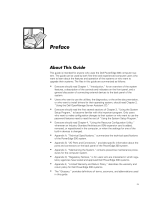Page is loading ...

xv
This guide is intended for anyone who wants to troubleshoot a Dell PowerApp.web
100 or Dell PowerApp.cache 100 Internet appliance. Before calling Dell for technical
assistance, follow the recommended procedure(s) in this guide.
In addition to this
Troubleshooting Guide
, the following documentation is included
with your system:
Setting Up Your Appliance,
which shows how to physically set up your Power-
App™ appliance for the first time.
Software documentation that describes how to configure, upgrade, or reinstall
the software on your system.
Rack installation guide.
User's Guide,
available online at http://support.dell.com. This document
includes information on system features, technical specifications, and information
about contacting Dell.
NOTE: Documentation updates are sometimes included with the system to describe
changes to the system or software. Always read these updates before consulting any
other documentation because the updates often contain information that supersedes
the information in the other documents.

xvi
Technical information files—sometimes called "readme" files—may be installed
on the hard-disk drive or on media to provide last-minute updates about technical
changes to the system or advanced technical reference material intended for
experienced users or technicians.
The following list defines (where appropriate) and illustrates typographical conven-
tions used as visual cues for specific elements of text throughout this document:
Interface components
are window titles, button and icon names, menu names
and selections, and other options that appear on the monitor screen or display.
They are presented in bold.
Example: Click OK.
Keycaps
are labels that appear on the keys on a keyboard. They are enclosed in
angle brackets.
Example: <Enter>
Key combinations
are series of keys to be pressed simultaneously (unless other-
wise indicated) to perform a single function.
Example: <Ctrl><Alt><Enter>
Commands
presented in lowercase bold are for reference purposes only and are
not intended to be typed when referenced.
Example: "Use the format command to . . . ."
In contrast, commands presented in the Courier New font are part of an instruc-
tion and intended to be typed.
Example: "Type format a: to format the diskette in drive A."
Filenames
and
directory names
are presented in lowercase bold.
Examples: autoexec.bat and c:\windows
Syntax lines
consist of a command and all its possible parameters. Commands
are presented in lowercase bold; variable parameters (those for which you substi-
tute a value) are presented in lowercase italics; constant parameters are
presented in lowercase bold. The brackets indicate items that are optional.
Example: del [
drive
:] [
path
]
filename
[/p]
Command lines
consist of a command and may include one or more of the com-
mand’s possible parameters. Command lines are presented in the Courier New
font.
Example: del c:\myfile.doc

xvii
Screen text
is a message or text that you are instructed to type as part of a com-
mand (referred to as a
command line
). Screen text is presented in the Courier
New font.
Example: The following message appears on your screen:
No boot device available
Example: "Type md c:\programs and press <Enter>."
Variables
are placeholders for which you substitute a value. They are presented in
italics.
Example: DIMM
_x
(where
x
represents the DIMM socket designation).

xviii
/
